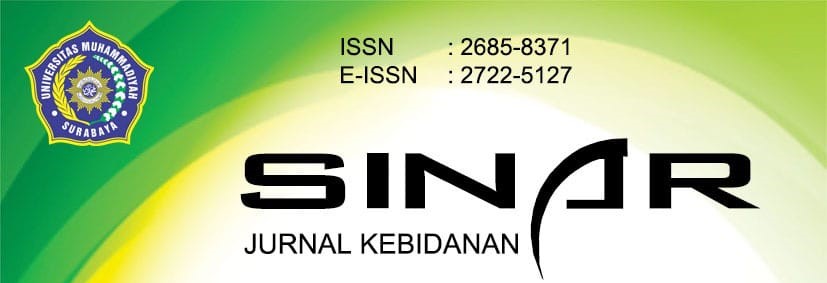PENGARUH MASSASE TERHADAP INTENSITAS NYERI PUNGGUNG PADA IBU HAMIL
Abstract
Objective: The discomfort that is often experienced by pregnant women in the second and third trimesters is back pain. Back massage with a gentle touch in the hip area can relieve lower back pain during pregnancy. The purpose of this research is to determine whether massage affects the intensity of back pain in pregnant women.
Methods: This study used a quasi-experimental design with pre and post-test type one group design. The population of this study was all third-trimester mothers who experienced back pain at Public Health Center Tanah Kalikedinding Surabaya in May-August 2020; samples were taken by Accidental Sampling, so 32 respondents were obtained. This study used univariate and bivariate data analysis using Wilcoxon.
Results: Back pain in third-trimester pregnant women before a back massage has an average of 4.42; after a back massage, the moderate pain is 3.18. There is an effect of back massage on back pain in third-trimester pregnant women. Statistical test results obtained t-test value and p-value 0.000 > 0.05.
Conclusion: There is an effect of back massage on back pain in third-trimester pregnant women at Public Health Center Tanah Kalikedinding Surabaya. Pregnant women who experience back pain are expected to increase their knowledge about back massage so that it can be applied at home.
Full text article
References
Amir, R., Leiba, R., & Eisenberg, E. (2019). Anchoring the numeric pain scale changes pain intensity reports in patients with chronic but not with acute pain. Pain Practice, 19(3), 283–288.
Archard, G. (2007). Simple Guide: Nyeri Punggung. Erlangga.
Argoff, C. (2011). Mechanisms of pain transmission and pharmacologic management. Current Medical Research and Opinion, 27(10), 2019–2031.
Campbell, T. S., Johnson, J. A., & Zernicke, K. A. (2020). Gate control theory of pain. In Encyclopedia of behavioral medicine (pp. 914–916). Springer.
Casagrande, D., Gugala, Z., Clark, S. M., & Lindsey, R. W. (2015). Low back pain and pelvic girdle pain in pregnancy. JAAOS-Journal of the American Academy of Orthopaedic Surgeons, 23(9), 539–549.
Hartati, H., Walin, W., & Widayanti, E. D. (2015). Pengaruh Teknik Relaksasi Front Effleurage terhadap Nyeri Dismenore. Jurnal Riset Kesehatan, 4(3), 793–797.
Mafikasari, A., & Kartikasari, R. A. (2015). Posisi tidur dengan kejadian back pain (nyeri punggung) pada ibu hamil trimester III. Surya, 7(02), 26–34.
Manyozo, S. (2019). Low back pain during pregnancy: Prevalence, risk factors and association with daily activities among pregnant women in urban Blantyre, Malawi. Malawi Medical Journal, 31(1), 71–76.
Mufdlilah. (2009). Panduan Asuhan Kebidanan Ibu Hamil. Nuha Medika. https://scholar.google.com/scholar?hl=en&as_sdt=0%2C5&q=Panduan+Asuhan+Kebidanan+Ibu+Hamil.+Yogyakarta+%3A+Nuha+Medika&btnG=
Nwuga, V. C. B. (2007). Techniques of spinal manual therapy. Manual Treatment of Back Pain. 2nd Ed. William and Wilkins, 115.
Pantikawati, S. (2010). Asuhan Kebidanan Pada Ibu Hamil. Jakarta: Nuha Medika.
Pravikasari, & Analisa, N. (2014). Perbedaan senam hamil dan teknik akupresur terhadap penurunan nyeri punggung bawah pada ibu hamil trimester III . Universitas Diponegoro.
Reeder, S. J., Martin, L. L., & Koniak-Griffin, D. (2011). Keperawatan maternitas: kesehatan wanita, bayi & keluarga.
Sunarti. (2013). Asuhan Kehamilan. In Media.
Tarsikah, T., & Silfiana, E. (2017). Penerapan Teknik Mekanika Tubuh untuk Mengurangi Nyeri Punggung pada Ibu Hamil Trimester II dan III. MIKIA: Mimbar Ilmiah Kesehatan Ibu Dan Anak (Maternal and Neonatal Health Journal), 4–9.
Widatiningsih, S., & Dewi, C. H. T. (2017). Praktik terbaik asuhan kehamilan. Yogyakarta: Trans Medika.
Authors
Hak Cipta ada di penulis, jurnal ini berada di bawah Lisensi
https://creativecommons.org/licenses/by-nc/4.0/

